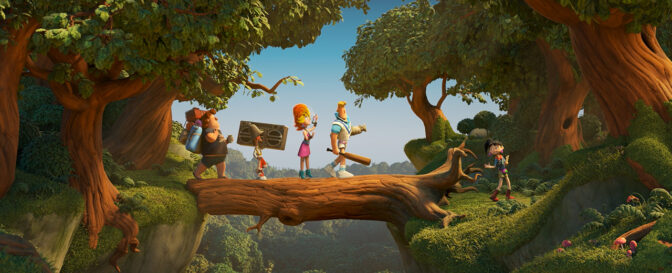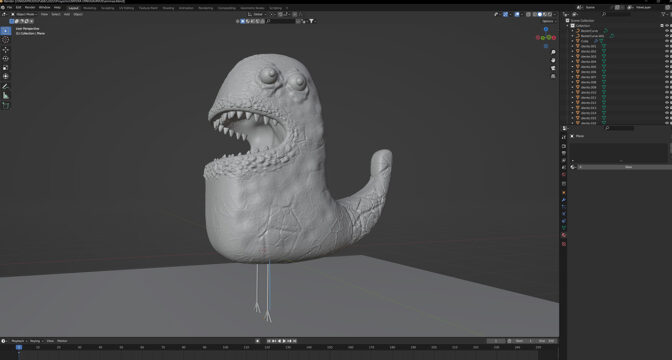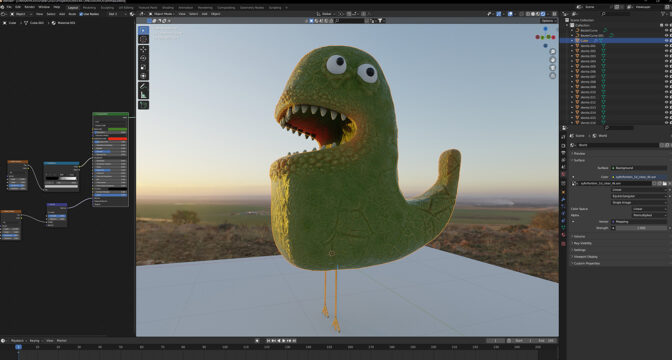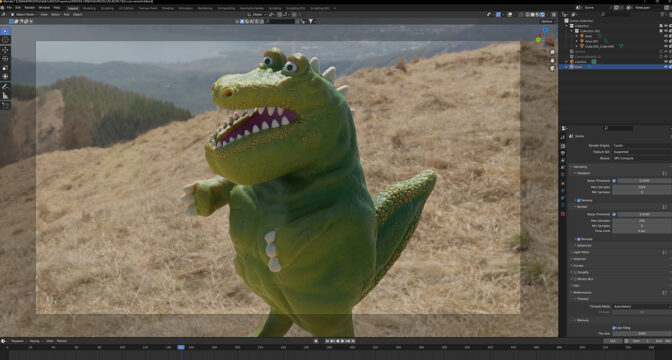Editor’s note: This post is part of our weekly In the NVIDIA Studio series, which celebrates featured artists, offers creative tips and tricks, and demonstrates how NVIDIA Studio technology improves creative workflows. We’re also deep diving on new GeForce RTX 40 Series GPU features, technologies and resources, and how they dramatically accelerate content creation.
It’s a celebration, creators!
Blender, the world’s most popular 3D creation suite — free and open source — released its major version 3.5 update. Expected to have a profound impact on 3D creative workflows, this latest release features support for Open Shading Language (OSL) shaders with the NVIDIA OptiX ray-tracing engine.
Plus, 3D artist and filmmaker Pablo Reche Beltrán, aka AuraProds, joins the 50th edition of the In the NVIDIA Studio series this week to share his Jurassic Park-inspired short film. Thank you to the artists who’ve contributed to the series, those who influence and inspire each day and those who will do so in the future.
Finally, enter the Watch ‘n Learn Giveaway hosted by creative community 80LV for a chance to win a powerful GeForce RTX 4080 GPU. Enter by watching an Omniverse for creators GTC session, filling out this form, and tagging #GTC23 and @NVIDIAOmniverse on social media by Thursday, March 30.
Better Renders in Blender 3.5
Supporting OSL shaders with NVIDIA OptiX, the Blender update 3.5 now enables 3D artists to use shaders in Cycles and render them on an NVIDIA RTX GPU. Previously, such a workflow was limited to CPU rendering only.

This saves an extraordinary amount of time for artists, as scenes that use OSL can be completely rendered 36x faster than with a CPU alone.
Blender 3.5 also delivers updates to creative workflows in animation and rigging, nodes and physics, modeling and more.
Read the full release notes.
Dino-mite Renders Never Go Extinct
3D artist AuraProds fondly remembers watching the blockbuster movie Jurassic Park in theaters as a kid, wishing to one day recreate a memorable scene in which a giant T-Rex frightens the main characters who are huddled together in a car. Unlike that scary moment, however, the artist’s AuraProds video came together in a rather cute way.
“The concept art was made by my five- and eight-year-old cousins,” said AuraProds. “They drew the dinosaurs and inspired me to turn them into 3D.”
Based in Almería, a small city in southern Spain, AuraProds was perfectly situated to capture video footage in the nearby town of Tabernas, where Hollywood directors often shoot western movies. With the requisite footage captured, AuraProds modeled dinosaurs to populate the scene.
His preferred 3D app is Blender. “No doubt,” said AuraProds. ”I really like it because I can bring to 3D any idea in my head with a simple workflow.”
The artist modeled and sculpted each dinosaur by hand, using Blender Cycles RTX-accelerated OptiX ray tracing in the viewport for interactive, photorealistic modeling, thanks to his GeForce RTX 4080 GPU.

Satisfied with the models, AuraProds experimented with a variety of textures before moving on to rig and animate his models. Motion-blur visual effects were applied quickly with accelerated rendering and NVIDIA NanoVBD for easier rendering of volumes.

RTX-accelerated OptiX ray tracing in Blender Cycles allowed AuraProds to quickly export fully rendered files to Blackmagic Design’s DaVinci Resolve software.

Here, AuraProds RTX GPU dramatically accelerated his compositing workflows. GPU-accelerated color grading, video editing and color scopes were applied with ease. And decoding with NVDEC, also GPU accelerated, enabled buttery-smooth playback and scrubbing of high-resolution footage.
“NVIDIA RTX GPUs are the only technology that could handle the massive amount of polygons for this project. I know from my own experience how reliable the GPUs are.”’ — AuraProds.
The RTX 4080 GPU sped AuraProds use of new AI video editing tools, delivering up to a 2x increase in AI performance over the previous generation. Performance boosts were also applied to existing RTX-accelerated AI features — including automatic tagging of clips and tracking of effects, SpeedWarp for smooth slow motion and Video Super Resolution.
AuraProds then applied several AI features to achieve his desired visual effect. He wrapped up the project by deploying the RTX 4080 GPU’s dual AV1 video encoders — cutting the export time in half.
“I got to bring that aesthetic and memory to this new digital age with today’s AI tools,” said AuraProds.

For more of AuraProds video content, check out VELOX — a short 3D film shot entirely with a green screen — made by scanning an entire desert and creating several 3D spaceships over two months, available on his YouTube channel.
Experienced and aspiring content creators can discover exclusive step-by-step tutorials from industry-leading artists, inspiring community showcases and more on the NVIDIA Studio YouTube channel, which includes a curated Blender playlist.
Follow NVIDIA Studio on Instagram, Twitter and Facebook. Get updates directly in your inbox by subscribing to the Studio newsletter.
